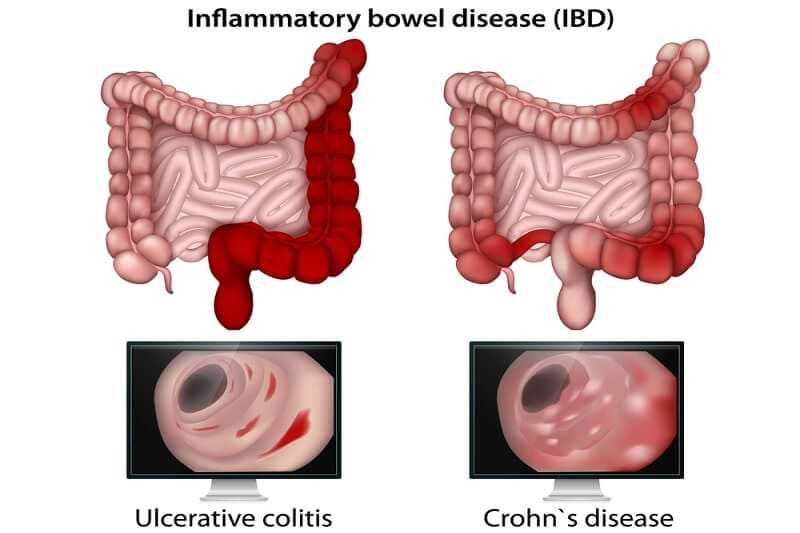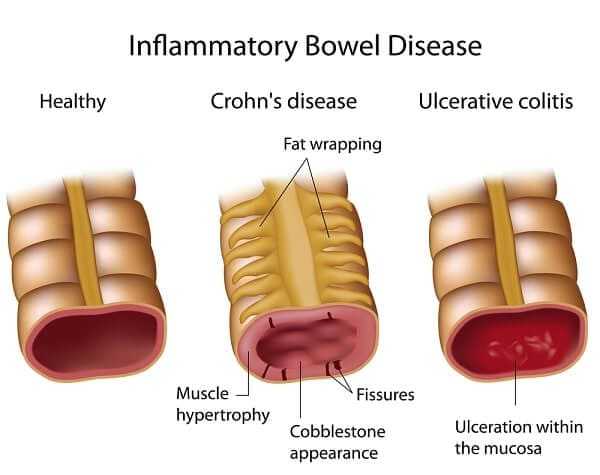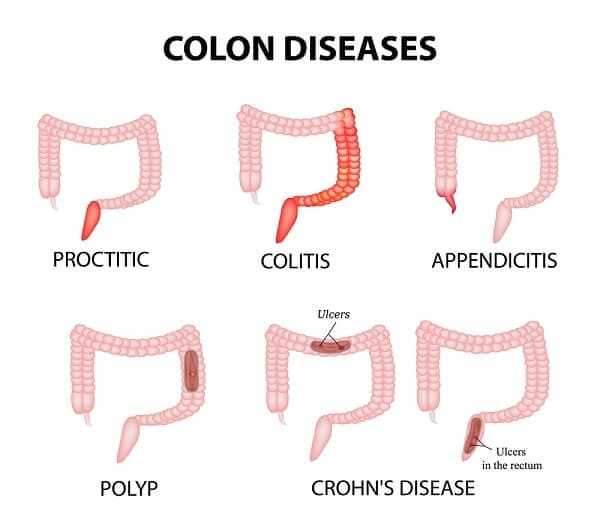Inflammatory Bowel Disease (IBD)

Inflammation – the word means “being set on fire” – is a localized protective response that occurs when tissue is damaged or destroyed. Its purpose is to wall off, dilute, or destroy an injurious agent. Acute inflammation is characterized by pain, heat, redness, and swelling. Chronic inflammation is a less dramatic process. It may proceed without any of these features, yet it results in distortion, and sometimes destruction, of tissues, often leading to permanent scarring.

Inflammatory bowel disease is just that – disease in which the bowel becomes inflamed. By convention the term refers to just two diseases: ulcerative colitis (UC) and Crohn’s disease (CD).
Both UC and CD probably first appeared as isolated cases several centuries ago, but they did not attract medical interest until the last half of the nineteenth century. Ulcerative colitis was described and named in 1875 in a medical textbook published in London, England. In 1913, Dalziel’s article in a British journal mentioned a group of patients with what was probably Crohn’s disease. But it wasn’t until a more widely publicized report was published in the United States in 1932 by Dr. Crohn and his colleagues that the disease came to be known as Crohn’s disease.
| It is common for different doctors to make up new names for specific diseases, especially those of unknown cause. Sometimes multiple names occur because what were thought to be two separate diseases turn out to be one and the same. For example, Crohn’s disease was originally thought to occur only in the small intestine, and not in the colon. Other Names for Ulcerative Colitis and Crohn’s Disease Ulcerative colitis (UC) • idiopathic ulcerative colitis (idiopathic means “of unknown cause”) • idiopathic proctocolitis • nonspecific ulcerative colitis Crohn’s disease (CD) • ileitis, terminal ileitis (“terminal” refers to the terminus or end of the ileum) • regional enteritis, regional ileitis • granulomatous ileitis/enteritis/colitis (“granulomatous” refers to a specific appearance under the microscope) • Crohn’s disease of the colon/ileum/jejunum/duodenum/stomach/ esophagus |
One Disease, Two, or More?
Some experts in the field have thought that ulcerative colitis and Crohn’s disease are merely two forms of the same disease, perhaps because some people who “clearly” have ulcerative colitis “clearly” develop features of Crohn’s disease at a later date. It is extremely rare, though, for an expert to diagnose Crohn’s colitis, and then change the diagnosis later to ulcerative colitis. It is also extremely rare for both diseases to coexist in one person.

Because we cannot always tell if the problem is ulcerative colitis or Crohn’s disease, we tell some patients that they have “indeterminate colitis.” This too has encouraged the perception of IBD as just one disease. In many cases, not being able to say which kind of colitis it is doesn’t matter. Except when surgery is necessary, most treatments are the same for both ulcerative colitis and Crohn’s disease.
Where Does Ulcerative Colitis Occur?
Ulcerative colitis occurs only in the colon. It always involves the rectum. It should be continuous – that is, not confined to patches.
Some patients have inflammation just in the rectum (known as ulcerative proctitis). Others have it in the rectum and the sigmoid colon. Some have it in the rectum, the sigmoid colon, and the descending colon up to the splenic flexure. Others have it from the rectum around into the transverse colon. Some have it as far as the hepatic flexure. Yet others have it throughout the entire colon to the cecum.

Ulcerative colitis involves the rectum plus or minus the sigmoid in 30 percent of cases, approximately the left half to two-thirds of the colon in 40 percent of cases, and the whole colon in 30 percent of cases.
Learning about medicine means accepting the fact that we can never say “never” and we can never say “always.” Occasionally there are patients in whom ulcerative colitis is not continuous. What we see then is involvement of the rectum and part of the descending colon, plus a patch in the cecum, usually around the opening into the appendix. The patch near the appendix looks just like ulcerative colitis anywhere else. As you will see, patchy disease is typical of Crohn’s disease; however, it is believed that these people with a patch of colitis around the appendix and typical ulcerative colitis elsewhere do in fact have ulcerative colitis.
In some patients with ulcerative colitis, the inner lining of the last few inches (centimeters) of the ileum becomes mildly inflamed. This inflammation is called backwash ileitis; it does not cause any symptoms or problems. We don’t know why some patients get backwash ileitis and others don’t.
Exactly What Is Inflamed in Ulcerative Colitis?
In ulcerative colitis, inflammation is usually confined to the inner lining of the colon, or mucosa . The surface of this inner lining becomes raw and bleeds easily, and looks a lot like scraped skin.
Where Does Crohn’s Disease Occur?
Crohn’s disease can occur anywhere from the mouth to the anus. Most commonly (45 percent) it occurs in the end of the ileum and the beginning of the colon (cecum plus or minus ascending colon). Next most commonly (35 percent) it occurs just in the end of the ileum. Third most commonly (20 percent) it occurs just in the colon. Here it may be patchy or continuous, and may or may not involve the rectum. In a few patients the jejunum, duodenum, stomach, or esophagus is involved. For most patients with inflammation in these areas, the ileum or the colon or both are involved as well, but in a few people the disease is isolated in one or more of those locations. When Crohn’s disease occurs in the mouth, it is almost always associated with Crohn’s disease elsewhere in the GI tract.

Exactly What Is Inflamed in Crohn’s Disease?
In Crohn’s disease, the entire thickness of the bowel wall, from the inner lining (the mucosa) through the muscle layers to the outer lining (the serosa ), is inflamed. In addition to swelling of the bowel wall, Crohn’s disease causes swelling of the mesentery , a fan-shaped piece of tissue that connects the small intestine to the back wall of the abdomen and contains the main intestinal blood vessels and lymph glands.





